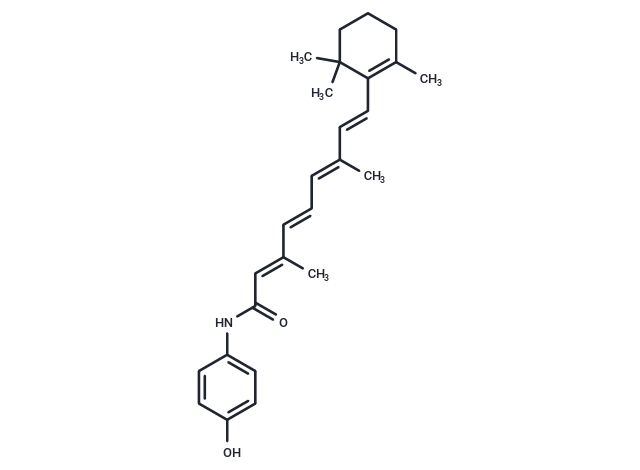Powder: -20°C for 3 years | In solvent: -80°C for 1 year
Fenretinide (4-HPR) is an orally-active synthetic retinoid derivative with potential antineoplastic and chemopreventive activities.

| パッケージサイズ | 在庫状況 | 単価(税別) | |||
|---|---|---|---|---|---|
| サンプルについてお問い合わせ | |||||
| 5 mg | 在庫あり | ¥ 8,000 | |||
| 10 mg | 在庫あり | ¥ 12,500 | |||
| 25 mg | 在庫あり | ¥ 18,500 | |||
| 50 mg | 在庫あり | ¥ 22,500 | |||
| 100 mg | 在庫あり | ¥ 29,500 | |||
| 200 mg | 在庫あり | ¥ 44,500 | |||
| 1 mL * 10 mM (in DMSO) | 在庫あり | ¥ 11,500 | |||
| 説明 | Fenretinide (4-HPR) is an orally-active synthetic retinoid derivative with potential antineoplastic and chemopreventive activities. |
| In vitro | Fenretinide demonstrates both immediate and sustained antitumor effects across several T-ALL cell lines and inhibits DES activity in CCRF-CEM leukemia cells, leading to increased endogenous cellular dhCer levels in a dose- and time-dependent manner. This includes (3 µM)-induced dhCer accumulation in CCRF-CEM and Jurkat cells [1]. Additionally, fenretinide enhances insulin signaling by protecting against ceramide-related inhibition and mitigates lipid-induced declines in insulin-stimulated glucose uptake [2]. It also effectively halts OVCAR-5 cell proliferation and viability at doses above 1 µM, achieving 70-90% growth inhibition at 10 µM, and notably impairs OVCAR-5 invasion following a 3-day preincubation period with 1 µM. Furthermore, endothelial cells exposed to 1µM 4-HPR fail to form tubular structures, instead creating small cellular clusters [4]. |
| In vivo | Fenretinide (10 mg/kg, i.p.) selectively inhibits ceramide accumulation HFD-fed male C57Bl/6 mice. Fenretinide treatment improves glucose tolerance and insulin sensitivity as determined by both glucose and insulin tolerance tests[2]. The addition of 25 mg/kg ketoconazole to Fenretinide increased 4-HPR plasma levels in NOD/SCID mice[3]. |
| 細胞研究 | Fenretinide is dissolved in DMSO. Standard XTT assay is used to determine cell viability. For fenretinide-only treatments, cells are plated in 96-well plates at 750,000 cells/mL and 100 μL/well. After 4 h, treatments are added on 50 μL/well obtaining a final density of 500,000 cells/mL and final volume of 150 μL/well. Four replicates are used per experimental condition. XTT reagent mixture is added 4 h before the end of selected treatment period and absorbance at 490 nm is determined per each well. A slightly modified protocol is used for analysis of the effect of myriocin (final concentration of 100 nM) or antioxidant on Fenretinide treatment. Briefly, cells are seeded on 60 mm culture dishes and myriocin or antioxidants added after 4 h. Fenretinide treatment is added 2 h later and cells are plated in quadruplicates in 96 well plates (150 μL/well). |
| 別名 | 4-HPR, MK-4016, 4-hydroxy(phenyl)retinamide |
| 分子量 | 391.55 |
| 分子式 | C26H33NO2 |
| CAS No. | 65646-68-6 |
Powder: -20°C for 3 years | In solvent: -80°C for 1 year
DMSO: 39.2 mg/mL(100 mM)
You can also refer to dose conversion for different animals. 詳細
bottom
Please see Inhibitor Handling Instructions for more frequently ask questions. Topics include: how to prepare stock solutions, how to store products, and cautions on cell-based assays & animal experiments, etc.
Fenretinide 65646-68-6 Autophagy Metabolism Retinoid Receptor 4-HPR Retinoic acid receptors MK4016 MK-4016 Inhibitor RAR/RXR 4-hydroxy(phenyl)retinamide inhibit MK 4016 Retinoid X receptors inhibitor
